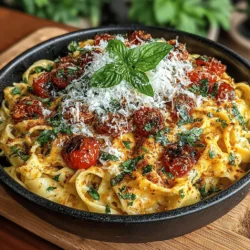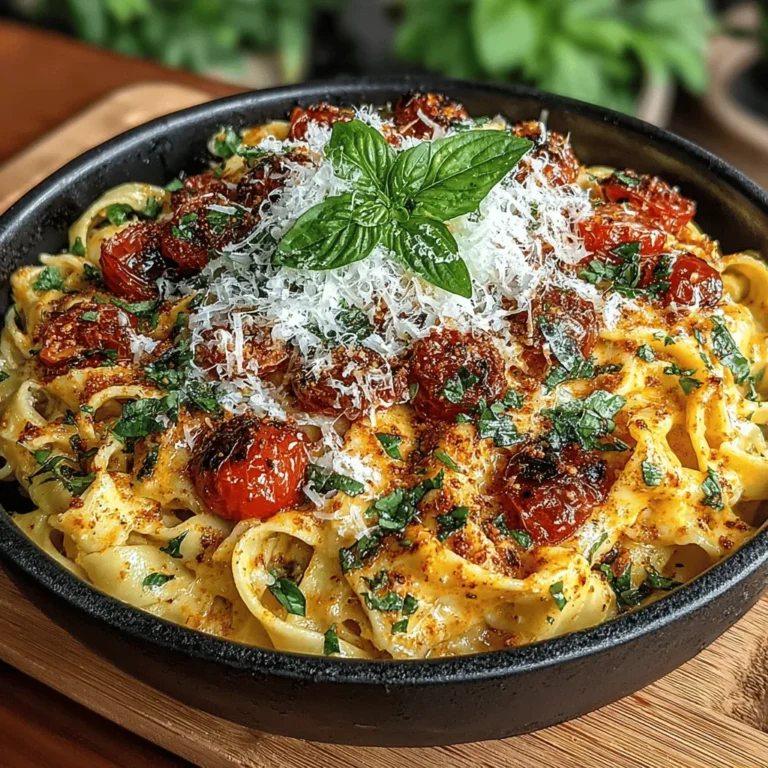In the realm of quick and satisfying meals, skillet pasta dishes have carved out a cherished place. Their appeal lies not only in their simplicity but also in the vibrant medley of flavors that can be achieved with just a few ingredients. Among these delightful recipes, Creamy Tomato Basil Skillet Pasta stands out, offering a rich, comforting blend of succulent tomatoes and aromatic basil that can transport your taste buds straight to Italy. This dish is an ideal choice for busy weeknights, providing a nutritious and satisfying meal that’s both easy to prepare and pleasing to the palate.
Understanding Skillet Pasta
Skillet pasta is a cooking method that combines the convenience of one-pot meals with the delightful flavors of Italian cuisine. Traditionally, pasta is boiled in a separate pot and then combined with sauce, but skillet pasta allows you to cook everything in a single pan, saving time and reducing cleanup. This method has its roots in rustic Italian cooking, where simplicity and flavor reign supreme. As culinary enthusiasts began to embrace the idea of one-pan meals, skillet pasta gained popularity for its versatility and ease of preparation.
One of the standout benefits of cooking pasta in a skillet is the ability to infuse the pasta with the flavors of the sauce. As the pasta cooks, it absorbs the rich essence of the ingredients, resulting in a dish that is not only flavorful but also cohesive. The reduced need for multiple pots and pans makes this method particularly appealing for weeknight dinners or casual gatherings, where you want to spend more time enjoying the meal and less time at the sink.
Key Ingredients for Creamy Tomato Basil Skillet Pasta
Crafting a delicious Creamy Tomato Basil Skillet Pasta requires a handful of key ingredients, each playing a crucial role in the overall flavor profile of the dish.
– Pasta: The choice between fettuccine and spaghetti can influence the texture and experience of the dish. Fettuccine, with its broad, flat shape, holds onto the creamy sauce beautifully, while spaghetti offers a classic, long noodle experience. Ultimately, the choice depends on personal preference—both options work wonderfully in this recipe.
– Tomatoes: For this dish, the type of tomatoes you select can make a significant difference. Ripe, fresh tomatoes are ideal, as their natural sweetness will enhance the overall flavor. If fresh tomatoes are not available, high-quality canned tomatoes can be a great alternative. Look for San Marzano or other varieties packed in juice for the best results.
– Fresh Basil: The aromatic quality of fresh basil is essential in this recipe, contributing a bright, herbaceous note that complements the rich tomato sauce. Basil is a cornerstone of Italian cuisine, and using fresh leaves instead of dried will elevate the dish dramatically.
– Garlic: Sautéing garlic releases its essential oils, creating a fragrant base for the sauce. The sweet, savory flavor of garlic is a hallmark of Italian cooking and adds depth to the overall dish.
– Cheese: A combination of creamy cheeses, such as cream cheese or mascarpone, will provide a luscious texture to the sauce. Grated Parmesan or Pecorino Romano is also essential for adding a salty, umami kick, enhancing the overall flavor experience.
Step-by-Step Guide to Making Creamy Tomato Basil Skillet Pasta
To embark on your culinary journey with Creamy Tomato Basil Skillet Pasta, start by preparing your ingredients. Here’s a detailed breakdown of the initial steps to set you up for success.
Preparing Ingredients
1. Gather Your Ingredients: Before diving into cooking, ensure you have all your ingredients ready. This includes your choice of pasta, fresh tomatoes, basil, garlic, and cheeses. Having everything within reach will streamline the cooking process.
2. Chop the Tomatoes: If using fresh tomatoes, wash and dice them into bite-sized pieces. This will help them cook evenly and integrate into the sauce smoothly.
3. Prepare the Basil: Rinse the basil leaves under cool water, gently pat them dry, and then chop them coarsely. Set aside a few whole leaves for garnish at the end.
4. Mince the Garlic: Peel and finely chop the garlic cloves. The size of the garlic pieces can impact the intensity of the flavor, so aim for a fine mince.
Selecting High-Quality Tomatoes and Fresh Basil
When it comes to Italian dishes, the quality of your ingredients can make all the difference. For tomatoes, look for those that are firm but slightly yielding to the touch, indicating ripeness. If opting for canned tomatoes, choose those labeled as “whole” for versatility in texture and flavor.
Fresh basil should be vibrant green with no signs of wilting or browning. The aroma of fresh basil is a strong indicator of its quality; the more fragrant, the better!
Cooking the Pasta to Perfection
1. Boil Water: In a large skillet, bring a generous amount of salted water to a boil. The salt is crucial as it enhances the pasta’s flavor.
2. Cook the Pasta: Add your chosen pasta to the boiling water and cook according to the package instructions, typically around 8-10 minutes. For the best results, aim for an al dente texture—firm to the bite but not hard. This is essential, as the pasta will continue to cook when combined with the sauce.
3. Save Pasta Water: Before draining the pasta, reserve about a cup of the starchy pasta cooking water. This liquid can be a game-changer when crafting your sauce, helping to achieve the perfect consistency.
Crafting the Sauce
1. Sauté Garlic: In the same skillet used for boiling the pasta, heat a drizzle of olive oil over medium heat. Once hot, add the minced garlic and sauté for about 30 seconds, or until fragrant. Be careful not to let it brown, as burnt garlic can introduce bitterness to your dish.
2. Add Tomatoes: Incorporate your chopped tomatoes into the skillet, stirring them in with the garlic. Allow them to simmer for a few minutes until they begin to break down and release their juices, creating a natural sauce.
3. Combine Ingredients: Once the tomatoes have softened, add the cooked pasta directly to the skillet. Mix everything together, allowing the pasta to soak up the flavorful sauce. If the mixture appears too dry, gradually add the reserved pasta water until you achieve your desired consistency.
4. Add Cheese: Stir in your creamy cheese of choice, allowing it to melt and blend with the sauce. This step is crucial for creating the rich, velvety texture that defines this dish.
5. Incorporate Basil: Finally, fold in the chopped basil, reserving a few leaves for garnish. The heat from the pasta will gently wilt the basil, releasing its aromatic qualities.
With these steps complete, you are well on your way to serving up a delightful Creamy Tomato Basil Skillet Pasta that is sure to impress family and friends alike. Stay tuned for the next part of this article, where we will explore tips for perfecting the dish and serving it beautifully.
{{image_2}}
Balancing Acidity with Cream and Seasonings
The key to achieving a well-rounded flavor in your creamy tomato basil skillet pasta lies in balancing acidity with cream and seasonings. Tomatoes, while delicious, can have a sharp acidity that may overwhelm the dish. Adding cream not only introduces a rich, velvety texture but also mellows the acidity, resulting in a harmonious blend of flavors.
Start by adding the cream gradually. This allows you to gauge the flavor as you mix it into the sauce. Stir and taste as you go; you may find that you need to add a pinch of sugar to counterbalance the acidity of the tomatoes. Fresh basil, with its aromatic and slightly sweet profile, also plays a crucial role in this balance. When you add the basil, do so towards the end of cooking to preserve its vibrant flavor and color.
The Cheese Melting Technique
One of the highlights of this dish is the melted cheese that coats the pasta. To achieve that creamy, irresistible texture, it’s essential to use the right melting technique. Grate your cheese finely—this ensures that it melts quickly and uniformly into the sauce.
Once your sauce and pasta are combined, remove the skillet from direct heat. Gradually sprinkle in the cheese while gently stirring. The residual heat will help the cheese melt smoothly without clumping. It’s crucial to avoid high heat at this stage, as it can cause the cheese to become stringy rather than creamy. For the best results, consider using a mix of cheeses, such as Parmesan for a sharp bite and mozzarella for that gooey texture.
Ensuring a Smooth, Creamy Sauce
To ensure your sauce remains smooth and creamy, pay attention to the cooking process. Start by sautéing garlic and onion in olive oil until fragrant, then add your tomatoes and allow them to cook down. This initial step forms the base of your sauce.
When you introduce the cream, make sure to stir continuously to prevent any separation. If you find that your sauce has thickened too much, you can easily adjust the consistency by adding a splash of pasta cooking water. This starchy water not only helps thin the sauce but also allows it to cling better to the pasta, enhancing the overall dish.
Combining Pasta and Sauce
Now comes the exciting part—combining the pasta with your luscious sauce. Once the pasta is al dente, carefully transfer it directly from the boiling water to the skillet containing your creamy sauce. This method allows the pasta to absorb some of the sauce, ensuring each bite is flavorful.
Gently toss the pasta in the sauce, making sure every piece is well-coated. If you notice your sauce is too thick or not adhering as you’d like, add a bit more of that reserved pasta water. This step is crucial for achieving the perfect texture and flavor distribution throughout the dish.
Tips for Achieving Perfect Coating
To achieve that ideal coating of sauce on each piece of pasta, follow these tips:
1. Use the Right Pasta: Opt for shapes that hold sauce well, such as fusilli or penne. These shapes trap the sauce in their spirals or tubes, ensuring a flavorful bite every time.
2. Timing is Key: Combine the pasta with the sauce immediately after draining. The heat from the pasta helps the sauce cling better, creating a more cohesive dish.
3. Toss, Don’t Stir: Use a gentle tossing motion rather than vigorous stirring. This protects the pasta from breaking while ensuring even distribution of the sauce.
4. Finish with Fresh Herbs: Just before serving, sprinkle freshly chopped basil on top. This not only adds a burst of color but also enhances the aroma and flavor profile of the dish.
Nutritional Value and Dietary Considerations
Caloric Content and Nutritional Breakdown
This creamy tomato basil skillet pasta is not only delicious but also offers a decent nutritional profile. A standard serving contains approximately:
– Calories: 500-600 kcal
– Carbohydrates: 60g
– Protein: 15g
– Fat: 25g
– Fiber: 3g
These values can vary based on the specific ingredients used, particularly the type and amount of cheese, cream, and pasta.
Options for Making the Dish Lighter or Accommodating Dietary Restrictions
If you’re looking to lighten up this dish, consider the following substitutions:
– Reduce the Cream: Use half-and-half, Greek yogurt, or a dairy-free alternative to cut calories while maintaining creaminess.
– Lower the Cheese: Opt for a smaller amount of cheese or use a strong-flavored cheese to achieve the desired taste with less quantity.
For those with dietary restrictions, gluten-free pasta options are widely available and can be used without sacrificing flavor. Additionally, dairy-free cheese can be used to accommodate lactose intolerance or dairy allergies.
Flavor Variations and Customizations
Exploring Spice Levels with Red Pepper Flakes
If you enjoy a bit of heat, adding red pepper flakes can elevate your creamy tomato basil skillet pasta. Start with a pinch and adjust according to your spice preference. This simple addition enhances the dish without overpowering the fresh flavors of basil and tomato.
Adding Protein: Chicken, Shrimp, or a Vegetarian Alternative
To transform this dish into a more filling meal, consider adding protein. Grilled chicken or sautéed shrimp pairs beautifully with the creamy sauce. For a vegetarian option, try incorporating chickpeas or sautéed mushrooms for added substance and a delightful texture.
Incorporating Seasonal Vegetables for Added Nutrition and Flavor
Take advantage of seasonal produce by adding vegetables such as spinach, zucchini, or bell peppers. Sauté these veggies alongside the onions and garlic to infuse additional flavors into your sauce while boosting the nutritional content of the dish.
Serving Suggestions and Pairings
Ideal Accompaniments: Bread, Salads, or Wine Pairings
This creamy tomato basil skillet pasta pairs wonderfully with a variety of sides. A crusty garlic bread is perfect for mopping up the sauce, while a fresh garden salad with a light vinaigrette complements the richness of the dish.
For wine lovers, a glass of Chardonnay or a light-bodied red like Pinot Noir rounds out the meal beautifully.
Presentation Tips for an Appealing Serving Style
Presentation matters! To serve this dish attractively, use a large, shallow bowl and twirl the pasta into a nest shape. Top it with additional cheese, fresh basil leaves, and a drizzle of olive oil for that restaurant-quality finish.
How to Store Leftovers and Reheat Without Sacrificing Flavor
If you have leftovers (which is rare with this delicious dish), store them in an airtight container in the refrigerator for up to 3 days. When reheating, add a splash of cream or pasta water to restore the creamy texture and prevent the sauce from drying out. Heat gently on the stove or in the microwave, stirring occasionally.
Conclusion
Creamy tomato basil skillet pasta is a delightful dish that brings together the richness of cream, the acidity of tomatoes, and the freshness of basil, all in one pan. Not only is it easy to prepare, but it also offers versatility, allowing for various adaptations based on your preferences and dietary needs.
This recipe is perfect for a quick weeknight dinner or a cozy gathering with friends and family. The joy of home-cooked meals lies in the ability to share delicious flavors and memories with loved ones. So grab your skillet and enjoy creating this comforting pasta dish that’s sure to become a staple in your kitchen.


